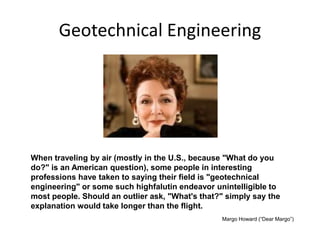Some Known Facts About Geotheta.
Some Known Facts About Geotheta.
Blog Article
Getting My Geotheta To Work
Table of ContentsGeotheta Can Be Fun For AnyoneAn Unbiased View of GeothetaGet This Report about GeothetaNot known Incorrect Statements About Geotheta The Basic Principles Of Geotheta

They conduct website investigations, gather samples, execute lab tests, and analyze information to assess the viability of the ground for building projects - Geo Tech Engineering. Based on their searchings for, geotechnical engineers give referrals for structure design, incline stability, keeping frameworks, and mitigation of geotechnical risks. They work together with other specialists, such as designers, architectural designers, and building teams, to ensure that geotechnical considerations are incorporated into the total task style and application
By evaluating the habits and residential or commercial properties of soil and rock, they can recognize potential geotechnical dangers such as landslides, soil settlement, or incline instability. Their knowledge aids prevent failures or crashes that might threaten lives and property. Here are some detailed duties and obligations of a geotechnical designer: Site Examination: Geotechnical designers conduct website investigations to collect information on subsurface conditions.
They analyze the data to understand the properties and behavior of the dirt and rock, including their stamina, leaks in the structure, compaction characteristics, and groundwater problems. Geotechnical Evaluation and Layout: Geotechnical engineers evaluate the data gathered throughout site examinations to examine the stability and suitability of the website for building jobs. They perform geotechnical calculations and modeling to examine variables such as bearing capacity, negotiation, incline security, side planet stress, and groundwater circulation.
The Basic Principles Of Geotheta
Foundation Layout: Geotechnical engineers play a crucial duty in designing structures that can safely support the designated framework. They assess the soil conditions and lots demands to identify the appropriate foundation kind, such as superficial foundations (e.g., grounds), deep structures (e.g (https://giphy.com/channel/geotheta)., stacks), or specialized methods like dirt renovation. They think about factors such as settlement limits, birthing ability, and soil-structure interaction to establish optimal structure layouts
They review building plans, monitor website tasks, and conduct field examinations to validate that the style suggestions are adhered to. If unforeseen geotechnical issues develop, they evaluate the situation and provide suggestions for remediation or modifications to the design. Risk Assessment and Reduction: Geotechnical engineers evaluate geotechnical threats and dangers connected with the task site, such as landslides, liquefaction, or soil disintegration.

Cooperation and Interaction: Geotechnical engineers work closely with various other experts associated with a job, such as designers, structural designers, and construction groups. Efficient interaction and collaboration are vital to integrate geotechnical considerations right into the overall job style and building process. Geotechnical designers provide technical know-how, answer inquiries, and make sure that geotechnical needs are fulfilled.
Not known Facts About Geotheta
Below are some kinds of geotechnical engineers: Foundation Engineer: Foundation designers concentrate original site on making and assessing structures for frameworks. They evaluate the dirt problems, tons demands, and site qualities to establish one of the most proper foundation type and layout, such as superficial structures, deep foundations, or specialized strategies like pile foundations.
They review the variables affecting slope stability, such as dirt homes, groundwater conditions, and slope geometry, and establish approaches to avoid slope failings and reduce dangers. Earthquake Engineer: Quake designers concentrate on examining and creating frameworks to withstand seismic forces. They evaluate the seismic hazard of a site, assess dirt liquefaction capacity, and create seismic design criteria to ensure the security and strength of structures throughout quakes.
They carry out field screening, gather examples, and evaluate the accumulated data to define the soil residential or commercial properties, geologic developments, and groundwater conditions at a website. Geotechnical Instrumentation Engineer: Geotechnical instrumentation designers concentrate on surveillance and determining the behavior of soil, rock, and structures. They mount and keep instrumentation systems that check aspects such as dirt negotiation, groundwater degrees, incline activities, and architectural displacements to examine performance and provide very early warnings of potential concerns.
Everything about Geotheta
They perform examinations such as triaxial examinations, combination examinations, straight shear examinations, and leaks in the structure examinations to collect data for geotechnical analysis and layout. Geosynthetics Engineer: Geosynthetics designers specialize in the design and application of geosynthetic products, such as geotextiles, geogrids, and geomembranes. They use these products to improve soil security, strengthen slopes, give water drainage remedies, and control erosion.
They tend to be investigatory people, which means they're intellectual, reflective, and analytical. They are curious, methodical, sensible, logical, and rational. Some of them are additionally social, meaning they're kind, charitable, participating, client, caring, useful, empathetic, skillful, and friendly - Consulting Engineers.
In the office setting, geotechnical designers utilize specialized software tools to do calculations, produce designs, and examine information. They prepare reports, testimonial project specs, communicate with customers and group participants, and coordinate project tasks. The office setup provides a favorable setting for research, evaluation, and partnership with various other experts entailed in the job.
Geotheta - Questions
They regularly check out project websites to conduct website examinations, evaluate geotechnical conditions, and collect data for evaluation. These check outs include taking a trip to various places, in some cases in remote or tough terrains. Geotechnical designers might do soil sampling, conduct tests, and display building tasks to ensure that the geotechnical facets of the task are being executed appropriately.
Geotechnical designers also function in specialized geotechnical research laboratories. In these facilities, they carry out experiments, do examinations on dirt and rock samples, and assess the engineering properties of the products. Geotechnical lab designers function thoroughly in these settings, handling testing tools, operating tools, and tape-recording data. They collaborate with other lab staff to make certain precise and reliable screening outcomes.
Report this page